So you’re wondering what happens to crime fiction when the country swoons into a prolonged period of economic recession, government corruption, political extremism, and overall disillusionment? In other words, you’re interested in the 1970s! Yes, it does seem more and more that the decade has quite a bit in common with our own period, which makes the literature all the more interesting to revisit, particularly the crime fiction, dedicated as it was to exploring America’s underbelly and the misfits, crooks, hustlers, and private eyes on the margins of society.
In the aftermath of the Sixties soft revolution and the souring of the counterculture, 1970s noirs often focused on runaway kids, ideals sold cheaply, land deals, and of course conspiracies galore. It was the heyday of some of the greatest writers ever to grace the genre, and it also saw the first expansions of major crime series set in cities outside the usual New York and California settings. Peruse some of the series below and find the ones that speak to you, then settle in for a long strange ride. We began this “binge read” project during the first phases of the lockdown, for those readers who wanted to explore a new period and wanted plenty of books to while away the hours. With the virus on the rise again in states across the continent, it looks like we’re still a ways from normalcy, so stock up on more books and plan on hunkering down with the classics.
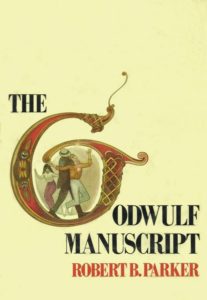
Robert B. Parker’s Spenser Series
Total Number of Series Installments: 40 (plus some good new ones by Ace Atkins)
First Novel Published: The Godwulf Manuscript (1973)
Last Novel Published: Sixkill (2011)
What can I say about Spenser that hasn’t already been said? Maybe it’s worth reviewing for a newer generation of readers: Spenser was a phenomenon, a wildly popular series that was surprisingly erudite without sacrificing any of the high-octane action. Without Spenser, there is no revival of Boston Noir. He defined the city for a while, and also contributed to the spread of crime fiction outside the traditional mystery capitals of New York and Los Angeles. Spenser was a boxer, a veteran, a former state trooper, a man with a rich perspective on romantic relationships, and one dogged investigator. Start at the beginning with The Godwulf Manuscript and you will get 1970s Boston with all its complicated textures, from the ivied halls to the streets. (Later on, you’ll have to search your own conscience and decide whether to watch the Netflix reboot.) Spenser is a classic detective in the Marlowe tradition, but created a new mold of his own.–Dwyer Murphy, CrimeReads Editor-in-Chief
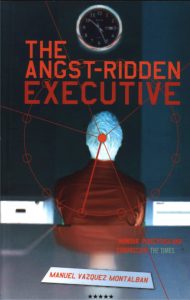
Manuel Vázquez Montalbán’s Pepe Carvalho Series
Total Number of Series Installments: 17
First Novel Published: I Killed Kennedy (1972)
Last Novel Published: Carvalho Millenium (2004)
Now seldom read in the US, there was a time when the Pepe Carvalho series was the gold standard for international detective fiction, and the books still more than hold their own. Carvalho was another disillusioned private eye, but his mean streets were those of Barcelona during an especially tumultuous period in Spain’s history, as the country emerged from the Franco era looking for a way forward into modernity and away from decades of internecine fighting. Pepe is a former member of the Communist party who still holds onto a few ideals, but he’s also an ex-stringer for the CIA, making him a man pretty thoroughly divided. His first allegiance, though, is to his home city, Barcelona, and its culture. A Pepe Carvalho case doubles as a pretty enticing guide to the foods and wines of Catalonia, as Pepe always finds time to stop off at a cafe for a little taste of something. These are, essentially, sensual novels that also traffic in some of the era’s most provocative ideas. If you’re curious what the Seventies in Western Europe might have been like for a slightly roguish man-of-the-world, there’s no better place to start than with this remarkable series.–DM
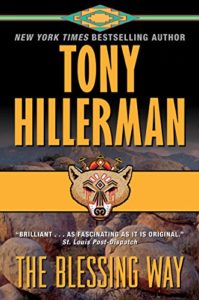
Tony Hillerman, Leaphorn and Chee Series
Total Number of Series Installments: 18
First Novel Published: The Blessing Way (1970)
Last Novel Published: The Shape Shifter (2006)
Hillerman dedicated decades to an academic career in anthropology studying the Navajo nation and their long history, so you won’t find a detail out of place when it comes to pottery in this long-running series featuring Navajo Tribal police officers Joe Leaphorn and Jim Chee. While we’re thankfully in a new Golden Age of indigenous authors writing crime, Hillerman’s carefully researched and well-written works stood out in the 1970s against a generally racist backdrop of narratives appropriating Native culture and trauma for white consumption. They did, however, find themselves adapted into some extremely mediocre films that are best lost to the sands of time. In a modified format, the series continues to this day, written by Hillerman’s daughter, Anne Hillerman.–Molly Odintz, CrimeReads Senior Editor
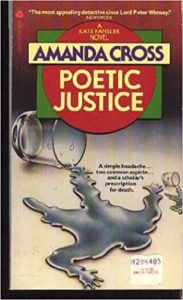
Carolyn Heilbrun’s Kate Fansler Series (MO)
Total Number of Series Installments: 15
First Novel Published: In the Last Analysis (1964)
Last Novel Published: The Edge of Doom (2002)
Disgruntled academic and pioneering feminist Carolyn Heilbrun wrote a number of mysteries under the pen name Amanda Cross, wherein her series heroine Kate Fansler raged at an unfair system and a chauvinistic academia while solving many a mystery. My mother, part of the first generation of feminist scholars to fight for tenure and representation at hide-bound universities, was a huge fan of these books.
Kate Fansler, an academic like her creator, used her knowledge of history and literature as the key to unraveling mysteries. As crime writer and academic Marlowe Benn points out in a recent article, “her adversaries are more likely to be attitudes and ideas than menacing brutes or homicidal masterminds.” Benn also notes that Heilbrun used her novels not only to generally process her frustrations at misogyny in the Ivory Tower, but also to obtain fictional revenge against specific colleagues of hers, including a longtime but problematic mentor and a pompous academic superstar. In fact, why are you even reading this blurb? Read Marlowe Benn’s article instead, then read the whole Amanda Cross series.–MO
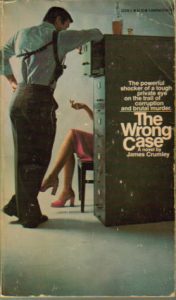
James Crumley’s Milo Milodragovitch and C.W. Sughrue Series
Total Number of Series Installments:
First Novel Published: The Wrong Case (1975)
Last Novel Published: The Right Madness (2005)
Ok so this is a little bit stretching the rules, first because we’re going to include two different series here, and second because each of those series only included one novel actually published in the 1970s, and yet how could you have a list of iconic Seventies crime fiction with the beating, bulging, sometimes secretly bleeding heart of that decade’s noir scene, James Crumley? Crumley captured the decade’s restless, rough-edged, drugged-out ethos to perfection, and he launched into it with two different series, both featuring private eyes working out of the town of Meriweather, Montana. Crumley acknowledged that Sughrue, the darker figure, represented some of his worst impulses and tendencies, while Milodragovitch tended his better angels. With 1978’s The Last Good Kiss (featuring Sughrue), Crumley penned one of the all-time great crime novels, but his earlier foray into crime, The Wrong Case (featuring Milo) is just as exhilarating to read. Together the two novels will give you a vivid, uproarious vision of the American West in a period when the American Dream was fraying at the edges and it took a couple of vets from a small-town in Montana to track down the country’s rogues and not-quite-solve its evolving mysteries.–DM
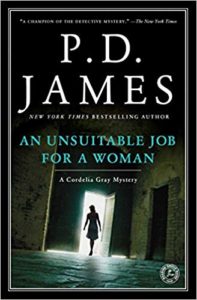
P.D. James’ Cordelia Gray Series
Total Number of Series Installments: 2 (plus 2 crossover cameos)
First Novel Published: An Unsuitable Job For a Woman (1977)
Last Novel Published: The Skull Beneath Her Skin (1982)
Cordelia Gray may have only been the star of two books, but her influence in the mystery canon looms large. In An Unsuitable Job for a Woman, Gray became one of the first women in fiction to run her own private detective agency, after the 22-year-old comes into the office one day only to discover that her partner, a retired policeman, has killed himself. Despite her youth and relative inexperience, she soon gets her first client as head of the agency when the assistant to a prominent scientist hires her to look into the apparent suicide of her employer’s son, who death turns out to be much more about money and social mores than any bout of depression. In The Skull Beneath Her Skin, the only other of James’ works to be told from Gray’s point of view, Cordelia is hired by an actress’s husband to accompany his wife as she heads to a remote island for a weekend getaway, but when the actress is murdered, it’s up to Cordelia Gray to find out the truth of the matter.
The appearance of Cordelia Gray heralded the rise of the female private investigator in the late 80s and 90s, and we’re forever grateful to P.D. James to showing us that in fiction (as in real life) women can do anything that men can do—and better. Of note, too, is the fact that men in Cordelia Gray’s life are as likely to mentor her, help her, hire her, or listen to her advice, as they are to attempt to obstruct or ignore her. The male allies of crime fiction today could learn a thing or two from the men in Cordelia Gray’s life.–MO

Donald Goines’ Kenyatta Series
Total Number of Series Installments: 4
First Novel Published: Crime Partners (1974)
Last Novel Published: Kenyatta’s Last Hit (1975)
Donald Goines was born to a middle class family in Detroit, but after a stint in the Air Force in Korea left him with a heroin addiction and a need to pour his pain out on paper, Goines became the perfect vehicle to take the urban fiction pioneered by Iceberg Slim and turn it into literature. Donald Goines’ Kenyatta series was published by Holloway House, a pulp and porn publisher that accidentally played mid-wife to the birth of Black pulp fiction while attempting to appeal to the prurient interests of white men, and the Kenyatta novels were the finest quality fiction ever sold by a porn pusher (including all those Playboy articles). Goines wrote the Kenyatta novels under the pseudonym A.C. Clark, while publishing several novels a year under various pen names. Their anti-hero lead, named after post-colonial leader Jomo Kenyatta, forms a Black-Panther-esque group to bring order to the ghetto in the first installment, and progressively find themselves immersed in ever wilder adventures and even deeper shit. There’s only four books in the series, but Goines also authored plenty of standalones if you want to keep reading. Goines and his partner sadly met a similar fate to many of their characters, both found murdered in their home, their killers never identified.–MO

Lawrence Block’s Bernie Rhodenbarr Series
Total Number of Series Installments: 11 novels plus short stories
First Novel Published: Burglars Can’t Be Choosers (1977)
Last Novel Published: The Burglar Who Counted the Spoons (2013)
Block is a name you’ll see again in future installments of this series, prolific and generations-spanning as he is. For the Seventies, Block offers up readers many respectable options, but let’s go with the Bernie Rhodenbarr series, since it had several excellent installments in that decade and captured something a little, well, weird about those years in an increasingly eccentric downtown New York City scene. Bernie runs a used bookshop in the Village and spends days chatting with the occasional customer or his dog-groomer buddy, Carolyn, but by night he puts his extraordinary skills as a burglar to use. His exploits inevitably send him on an odyssey through the various underworlds of New York, navigating between fences, crooks, antiques experts, and the occasional love interest. Block is the quintessential NYC crime writer, and he’s been at the game as long as anybody. Without a doubt, in the late 70s, he was entering into a golden era of smart, witty noir.–DM
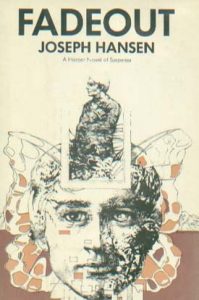
Joseph Hansen’s Dave Brandstretter series
Total Number of Series Installments: 14
First Novel Published: Fadeout (1970)
Last Novel Published: A Country of Old Men (1991)
Joseph Hansen’s long running GLBTQ series featuring insurance investigator Dave Brandstretter was one of the first series to feature an openly gay detective. Brandstretter was as hard-boiled as any detective, with a past history of serving in the Korean War, and he used his tough-talking skills to get to the bottom of many a complex mystery as the natural heir to the characters of James M. Cain. Joseph Hansen was also a poet, as evidenced by the lyrical quality of his novels and dedication to his craft. As a gay man married to a lesbian for over 50 years, his personal life was unconventional yet full of love; he and his wife shared a mutual admiration and enjoyed the freedom to pursue other relationships outside their marriage.–MO
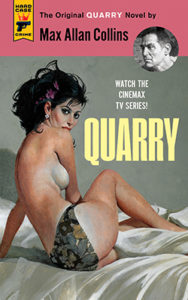
Max Allan Collins’s Quarry series
Total Number of Series Installments: 15
First Novel Published: Quarry (aka The Broker), 1976
Last Novel Published: Killing Quarry (2019)
If you listen closely, you can just about hear the Credence Clearwater Revival records playing in the background of Max Allan Collins’ Quarry books, so evocative are they of that moment in the early 1970s when the troops were coming home and the country was going to seed. Or maybe that should be something even bluesier, since the Quarry books are set in and around Memphis. The setup is fairly simple: a man comes home from Vietnam with the scarlet letter of a presumed war crime on his chest; his prospects are few and his skills highly particular. Soon he’s recruited by a shadowy organized crime figure named “The Broker,” who strongarms him into a new life as a hitman. If that isn’t the degradation of American society (and its returning military) right there in a nutshell, I don’t know what is. There are plenty of installments to this ultra-noir series, and when you’re done check out the excellent series, which only ran one season on Cinemax but was one of the best, most poignant crime shows in recent memory.–DM

















